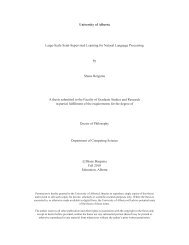The high altitude wildlife areas of western Arunachal Pradesh
The high altitude wildlife areas of western Arunachal Pradesh
The high altitude wildlife areas of western Arunachal Pradesh
Create successful ePaper yourself
Turn your PDF publications into a flip-book with our unique Google optimized e-Paper software.
7 6<br />
7 1<br />
Introduction<br />
92.0 °<br />
92.5 °<br />
93.0 °<br />
1<br />
2<br />
3<br />
5<br />
6<br />
27.6 º<br />
Tawang<br />
4<br />
West Kameng<br />
27.1 º<br />
N<br />
0 50 km<br />
92.0 °<br />
Fig. 2. <strong>The</strong> six <strong>high</strong> <strong>altitude</strong> regions in Tawang and West Kameng districts <strong>of</strong> <strong>Arunachal</strong> <strong>Pradesh</strong>.<br />
1 Upper Nyamjang Chu Valley; 2 Lower Nyamjang Chu Valley; 3 PTSO; 4 Mukto; 5 Mago Chu<br />
Valley and 6 High Altitude West Kameng<br />
prevented from going to elevations above 3000 m by the army, and most <strong>of</strong> the<br />
information presented from that region comes from interviews and village surveys.<br />
We conducted extensive field surveys in the <strong>high</strong> <strong>altitude</strong>s with the assistance<br />
<strong>of</strong> local guides, herders, and hunters, covering 740-800 km by road and at least 211 km<br />
on foot. We scanned the slopes from vantage points for large vertebrate <strong>wildlife</strong>, using<br />
spotting scopes and binoculars. Sighting records <strong>of</strong> all mammal and bird species were<br />
maintained, including their location, <strong>altitude</strong>, and habitat type. Indirect signs <strong>of</strong><br />
<strong>wildlife</strong> were also recorded (e.g. faeces, skins, and horns). We recorded GPS locations<br />
across the landscape, and made notes on vegetation and habitat. This information was<br />
used together with satellite imageries to develop vegetation maps.<br />
We conducted extensive interviews and informal discussions with hunters and<br />
herders for information on species occurrence. We showed them photographs and<br />
92.5 °<br />
93.0 °<br />
We collected information on <strong>wildlife</strong> occurrence through extensive field surveys, by examining <strong>wildlife</strong><br />
trophies and skins, and also by interviewing villagers, herders and hunters.<br />
5

















